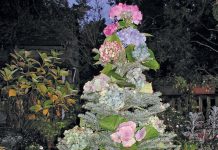The weather has been perfect for us to have great fall color this year. Because it’s been warm during the day and chilly at night I’m looking forward to the show. Many trees and shrubs are already showing color because they are stressed from a lack of water. Others will wait their turn and baring a wind storm which would dry out leaves before their time we’re in for a beautiful fall.
The vivid colors in a leaf are always there. They are just masked by the green chlorophyll which is busy making food by photosynthesis while the sun shines.
Come autumn, shorter days and cooler temperatures cause the trees to switch to energy-storage mode, and their leaves stop producing chlorophyll. The leaves actually develop a corky layer of cells between the leaf stalk and the woody part of the tree. This slows the transport of water and carbohydrates. The manufacture of chlorophyll is slowed and the green color of the leaves begins to fade, allowing the other pigments to show through. For the few weeks, before the leaves fall to the ground, they are colored only by their natural pigments that have built up in the sap. Depending on the acidity of the sap—red and purple anthocyanins, yellow and orange carotenoids—fall foliage can be glorious, sometimes anyway.
I read that the fall color in the eastern U.S. is not quite as great this year due to its exceptionally hot and dry summer. The Rockies are rockin’ it this autumn because of the summer’s monsoon rains. And our own Eastern Sierra Quaking aspen show is in full swing.
Quaking aspen (Populua tremuloides) is the most widespread tree species in North America. They generally grow in high-altitude areas but also exist at sea level in high places along the Pacific coast where climate conditions are ideal. Quaking aspen provides food for foraging animals and a habitat for wildlife. They also act as a fuel break retaining much more water in the environment than most conifer species.
High mountain systems, such as the Sierra Nevada, are uniquely sensitive to global climate changes and act as “canaries in the coal mine” providing early signals of significant climate-driven changes. Research in the Sierra Nevada by Pacific Southwest Research Station, a USDA Forest Service research organization, shows how vegetation has responded to the climate in the past and indicates changes that might be coming in the future over the next decade.
Climate has a profound influence on shaping our environment and natural resources. By looking at tree ring records of living and ancient wood and pollen lake sediments present, climate can be compared to historic patterns to show climate changes.
Research indicates a complex, unpredictable future for aspen in the West, where increased drought, ozone and insect outbreaks will compete with carbon dioxide fertilization and warmer soils with unknown cumulative effects. Aspen are vulnerable in the face of climate change. Hopefully, we will not lose this wonderful tree in California.
Which plants put on the best show in our area? Here are some of my favorites.
California native Western redbud turns yellow or red in the fall if conditions allow. This plant is truly a four-season plant starting in spring with magenta flowers, then leafing out with apple green heart-shaped leaves. Colorful seed pods give way to fall color. This small native tree or large shrub does well as a patio tree in gardens with good drainage.
Other California native plants like Western dogwood, Spicebush and Western azalea turn yellow, red or gold in the fall. A native vine that lights up with the onset of autumn is Rogers Red California grape. If you have an arbor, wall or fence that needs covering quickly this is your plant. The green and gray leaves are transformed in autumn into great draperies of rich, scarlet red leaves with clusters of summer fruit turning all shades of purple.
Trees and shrubs that also provide fall color include Eastern dogwood, Chinese flame tree, Ginkgo, Idaho locust, Chinese Tallow, Chinese pistache, crape myrtle, smokebush, witch hazel, all maples, liquidambar, katsura, Eastern redbud, sumac, crabapple, goldenrain, locust. oak leaf hydrangea and barberries.
Edibles that turn color in the fall include blueberries, pomegranate and persimmons.
Light up your garden as the light fades and the days shorten. Now through late fall is a good time to shop for plants that change colors because you can see in person just what shade of crimson, orange, scarlet or gold they will be.
Jan Nelson, a landscape designer and California-certified nursery professional, will answer questions about gardening in the Santa Cruz Mountains. Email her at ja******@*ol.com, or visit jannelsonlandscapedesign.com.













